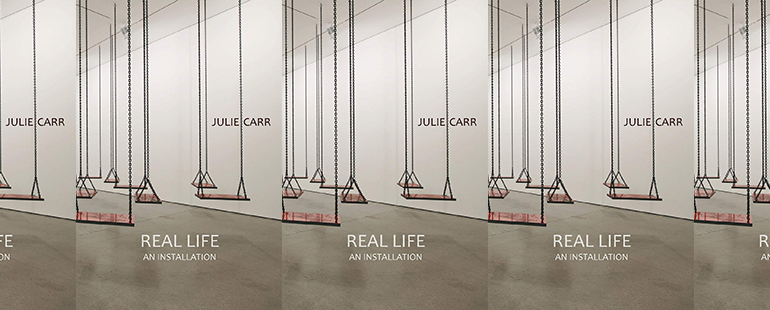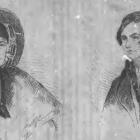Accumulation in Real Life: An Installation

Julie Carr’s 2018 poetry collection, Real Life: An Installation, is organized around three main areas: the speaker’s family life, the socio-political news facts that the speaker encounters in daily life, and the speaker’s descriptions of or instructions for art installations. These art installations, named in the book’s title, are described by the speaker as being designed to attempt to “figure violence without itself being violent” and also to create “a purely liquid experience,” something beyond the capacity of language.
Throughout all three of these main areas of exploration, Carr uses a technique that I will call “accumulation.” While many (perhaps most) contemporary collections are designed to either be read as a whole, or to be read as independent poems, the poems in Real Life: An Installation seem woven into each other and dependent upon each other for their cumulative force. This is not to say that the book’s individual poems couldn’t be read alone, but that, taken out of the collection, they would be missing the oomph that is collected along the journey.
One poem that illustrates this type of accumulation within itself is “Interlude: 10 Derivatives.” This poem is written in a style consistent with other pieces in Real Life: An Installation, but it is one of the book’s longest poems, which makes it a sort of microcosm of the technique of accumulation that is used throughout the whole. I’m using the word “accumulation” here to refer to the collecting of images, statistics, news bites, phrases, and conversations that Carr employs. These are often partial—a part of a conversation instead of the full, or even a part of a phrase or sentence instead of the whole.
“Interlude: 10 Derivatives” begins with section 1, “All that is Solid (or what I know about the body),” which, in prose poem form, is a list of facts about the human body. The body, especially a woman’s body, is one of the main sites of inquiry in this collection, and here the speaker has one of the most spacious moments in the collection, in which there is a list of all “I know about the body.” Section 1 begins: “Fluid sits in the ear, waiting for sound. The nervous system holds memories of pain and pleasure for an entire lifetime. Tightness in the palate or tongue causes corresponding tightness in the pelvic floor and cervix. The diaphragm flutters.” It ends: “Desire is imaginary. Beginning we are two, concluding, we are one. Teeth go first, last longest. A chip in a bone will not heal. The brain will be lost, becoming only an ambient teleology.” By themselves, none of these body facts is particularly stunning. It is the way that they build upon each other, particularly in the terse, short phrases Carr employs—“The diaphragm flutters…Touch stimulates brain growth. Oxytocin fires in bursts”—that works to create the ambience of overwhelm, the sensation of inundation of facts and events that pervades Real Life: An Installation.
In section 2 of “Interlude: 10 Derivatives,” “So Will You,” this overwhelm becomes even more exaggerated on the page, as the accumulation of bits and pieces breaks apart further. No longer even attempting to be whole sentences, this section appears on the page as fractions separated by dashes: “enter the lyrical stream?—socialism returns to France—Wisconsin’s girls get pregnant at 19, 20, 21—is someone crying upstairs?—the news suggests a shift from austerity—toward what lycanthropic dream?—the whistling of my son—how do the markets respond?” This section employs not only accumulation but also interruption and fragmentation, showing the speaker’s inability to take in and process all that arises within and without. The small domestic and embodied details (someone crying, the son whistling) jostle with the “big news” (socialism returns to France, how do the markets respond).
In section 3, Carr begins with news about a political candidate and proposed budget cuts (the Ryan plan), and writes, “My response is to let my plant die, an austerity / measure.” The poem then quickly shifts to gas, an imagined (sarcastic) alignment with the CEO of Exxon Mobil, and then with the wealth of the president of the Ohio University system, ending with, “With a dandelion in my shirt pocket, I am on the living list / of living people where I reside.” This rapid slaloming, in just thirteen lines, between federal budget cuts, fossil fuel executives, the speaker’s home and children, and the university president’s salary, shows the power of fast-moving juxtaposition in this method of accumulation. One of these images or facts on its own, or even two of them, would not create the same overwhelming, almost head-spinning effect as having all of them together in such a tight space. The effect is not only one of overwhelm but of claustrophobia—how can so much be happening in such a small place, in the interior of the poem and of the speaker? How can we bear it?
Later in the collection, Carr writes, “And then, with such statistics in mind, do we write more or do we write / less?” This question seems central to the push and pull of Real Life: An Installation—the statistics constantly inserting themselves into the life and writing of the speaker, the struggle to decide what to do with these facts, what to do with this life. The poem “The He-Structure” is perhaps the poem in the collection that most directly looks at this question:
This morning, as the sun stay more or less still and we revolve, all 300,000,000 of us, or those who look at things on screens, are gazing on the faces of five men, gray or balding, earners of at least ½ a million a year, each of whom knew that one in their group was raping boys in showers and not one of whom said so. Also, he forced them to suck him, and he masturbated on them.
I, just like you, allow no limits on my looking. Because I am free, beautifully free, I look at everything they give me to look at.
And into my freedom I inflict
the punishment of brute
fact.
“And into my freedom I inflict / the punishment of brute / fact,” Carr writes, and for the reader, this happens also. Carr inflicts these brute facts into our awareness, not just one little factoid at a time, not in a “neat” or “clean” way (although her poems are often quite sparse), but within a sort of deluge or swirl of all that is happening in a life: family, work, health, house, love. The brute facts are part of real life and they also shred our real lives.
The art installations that Carr discusses and provides instructions for throughout the collection often feature the body, and its relationship to the viewer or audience, and its relationship to these “brute facts.” In “Installations Discussed,” Carr writes:
I wanted to see the body split without splitting a body. I wanted it to be “real.” Why did I want this? I wanted to give my identity, my name, my family name, and my wallet in exchange for a purely liquid experience, but not one that I could never leave. Sometimes I wanted the opposite: to enter a room in which my body would become permanently marked (it was so already), in which other women would mark me.
Later in “Installations Discussed,” the speaker says, “Then I realized I had not invented this fantasy, but had borrowed it from the male…the best display-case possible, a simple hole in the ground. But then there could be no viewer,” highlighting another one of the central concerns of Real Life: An Installation: what to do with both the viewer, and with that which cannot be viewed.
“And now, having no one to receive these missives, I write into the space between / atoms, the emptiness of organs lying dormant, all the aborted plans—” Real Life: An Installation does, indeed, feel like a container for holding all these missives, messy and fragmented and whirling as they are. All writing, of course, could be seen as writing into the space, the emptiness, but Carr’s use of blank space on the page and repeated descriptions of installations, further create the sensation that this collection is a sort of structure, a space where these images, conversations, questions, and all else that is unbearable have been contained.



